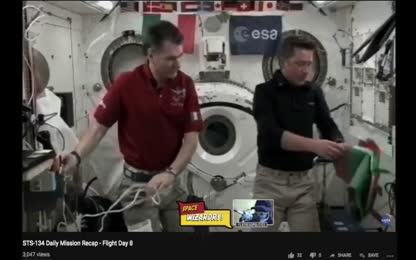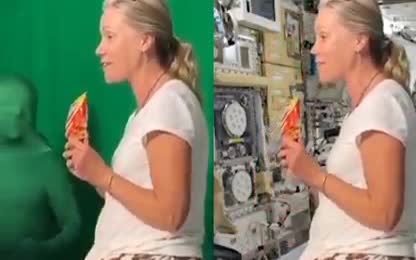Advertisement
JIM FETZER and GARY KING "NASA REDUX: If we had gone, we could NOT have come back!"
Jim Fetzer and Gary King review the history of the moon landing hoax,
from JFK declaration of our intention to put a man on the moon to the many proofs
that not only did it not happen but that, if we'd done it, we could not have come back.
- Category: NASA / ISS /Mars/ Moon Landing,NationalAgency of SpaceActors ,The New JFK Show ,The Raw Deal
- Duration: 48:45
- Date: 2019-08-07 01:31:16
- Tags: fetzer, gary king, moon landing, hoax, van allen belt, radiation, apollo, nasa, armstrong, aldrin
6 Comments
Video Transcript:
Welcome to the new JFK Show number 241, also known as the JFK Special. As you know, we've been inundated with nothing but Apollo space mission moon landing propaganda for weeks now on in. So what we want to do, the first thing I like to do is welcome you to the show, Dr. Fesser. I know you're 100% truth and I know we're in good hands right now on this very very important subject to me. All right. Now I really, in my baby book, it has my first locket of hair is also a moon, a clipping of the moon landing that day. All right. My first girlfriend all the way and on that day in my baby book with my picture of my nine-year-old birthday is the moon landing. I had moon landing stuff on my, so I loved it. I really did. And I love it. I love it. But at the moment, I have to say something else. Nasty. Just what have you done? What have you done with our money? What have you done with the promises? And it just floors me. So we're going to go ahead and start out from the very beginning with Jack spelling it out for us. And I think this isn't the normal one that we always see. I think this is just loaded. And Dr. Fesser, feel welcome to pause at any time when you see that scoundrel LBJ in the background. I mean, I'm eager to watch this with you, Gary. Yeah. I'm telling you, look at O LBJ. There's telling you a lot of stuff. And you may know some of the dignitaries a little better than I do. But he's in Texas and he's in the snake pit right now. And I'm sure. Yeah. President Kitson. Mr. Vice President. Governor. Congressman Thomas. Senator Wiley and Congressman Miller. Mr. Webb. Bell. Scientists. Stingwish guests. Ladies and gentlemen, I appreciate your president having made me an honorary visiting professor. And I will assure you that my first lecture will be a very brave. I am delighted to be here. And I'm particularly delighted to be here on this occasion. We meet at a college noted for knowledge in a city noted for progress in a state noted for strength. And we stand in need of all three. But we meet in an hour of change and challenge in a decade of both and fear in an age of both knowledge and ignorance. The greater our knowledge increases, the greater our ignorance unfolds. Despite the striking fact that most of the scientists that the world has ever known are alive and working today, despite the fact that this nation's own scientific manpower is doubling every 12 years in a rate of growth more than three times that of our population as a whole. Despite that, the vast stretches of the unknown and the unanswered and the unfinished still far outstripped our collective comprehension. No man can fully grasp how far and how fast we have come. But condense if you will, the 50,000 years of man's recorded history in a time span of about a half a century. Stayed in these terms, we know very little about the first 40 years, except at the end of them, advanced man had learned to use the skins of animals to cover them. Then about 10 years ago, under this standard, man emerged from his haves to construct other kinds of shelter. Only five years ago, man learned to write and use a cop with wheels. Christianity began less than two years ago. The printing press came this year and then less than two months ago during this whole 50 years span of human history. The steam engine provided a new source of power. Newton explored the meaning of gravity. Last month, electric lights and telephones and automobiles and airplanes became available. Only last week did we develop penicillin and television and nuclear power. And now, if America's new space craft succeeds in reaching Venus, we will have literally reached the stars before midnight tonight. This is a breathtaking pace. And such a pace cannot help but create new eels as it dispels old, new ignorance, new problems, new dangers. Surely the opening vistas of space promised my cause and hardships as well as high reward. So it is not surprising that some would have us stay where we are a little longer to rest, to wait. But this city of Houston, this state of Texas, this country of the United States was not built by those who waited and rested and wished to look behind them. This country was haunted by those who moved forward and so was space. William Bradford, and speaking in 1630 of the founding of the Plymouth Bay colony said that all great and honorable actions are accompanied with great difficulty. And both must be underpriced and overcome with admirable courage. If this capsule history of our progress teaches us anything, it is that man and his quest for knowledge and progress is determined and cannot be deterred. The exploration of space will go ahead, whether we join in it or not. And it is one of the great adventures of all time and no nation which expects to be the leader of other nations can expect to stay behind in this race for space. Those who came before us made certain that this country rode the first waves of the industrial revolution. The first waves of modern invention and the first wave of nuclear power and this generation does not intend to founder in the backwash of the coming age of space. We mean to be a part of it. We mean to lead it. For the eyes of the world, now looking to space to the moon and to the planets beyond. And we have vowed that we shall not see it governed by a hostile flag of conquest but by a banner of freedom. And peace, we have vowed that we shall not see space filled with weapons of mass destruction but with instruments of knowledge and understanding. Yet the vows of this nation can only be fulfilled if we in this nation are first and therefore we intend to be first. In short, our leadership in science and industry, our hopes for peace and security, our obligations to ourselves as well as others all require us to make this effort to solve these mysteries, to solve them for the good of all men and to become the world's leading space bearing nation. We set sail on this new scene because there is new knowledge to be gained and new rights to be won and they must be won and used for the progress of all people. For space science, like nuclear science and all technology, has no conscience of its own. Whether it will become a force for good or ill depends on man and only if the United States occupies a position of preeminence. Can we help decide whether this new ocean will be a sea of peace or a new terrifying dinner of war? I do not say that we should or will go unprotected against the hostile misuse of space. Any more than we go unprotected against the hostile use of land or sea. But I do say that space can be explored and mastered without feeding the fires of war, without repeating the mistakes that man has made in extending his writ around this globe of hours. There is no stripe, no prejudice, no national conflict in out of space as yet. It has been a hostile to us all. It has come quest deserves the best of all mankind. And its opportunity for peaceful cooperation may never come again. But why some say the moon? Why choose this as our goal? And they may well ask why climb the highest mountain? Five thirty five years ago, fly the Atlantic. Why does rice play Texas? We choose to go to the moon. We choose to go to the moon. We choose to go to the moon and disditate and do the other thing, not because they are easy but because they are hot. It is just nasty. It is really disappointing me very very much. I have got another clip here real quick. This is Gus Grissom saying how in the hell are we going to go to the moon when we can't communicate between three buildings? I guess the moon can probably be building. I can't hear that. I can't hear that. Okay. All right. But now we have to get the moon and we can't probably be building. They knew he wouldn't compromise Gary. They knew Gus Grissom wouldn't fall. They knew Gus Grissom wouldn't play the game. They knew Gus Grissom wouldn't fake it. I'm sorry. And that's the last you hear from Gus Grissom. He's not going to be complaining about the moon program any longer and of course you know he'd hung a lemon on his desk. Yeah, that one's really difficult so I just want to confirm a little bit more what he was trying to say. fun. Oh Wow. I'm not going to be able to do it. I'm not going to be able to do it. I'm not going to be able to do it. I'm not going to be able to do it. I'm not going to be able to do it. I'm not going to be able to do it. I'm not going to be able to do it. I'm not going to be able to do it. I'm not going to be able to do it. I'm not going to be able to do it. I'm not going to be able to do it. I'm not going to be able to do it. I'm not going to be able to do it. I'm not going to be able to do it. I'm not going to be able to do it. I'm not going to be able to do it. I'm not going to be able to do it. I'm not going to be able to do it. I'm not going to be able to do it. I'm not going to be able to do it. I'm not going to be able to do it. I'm not going to be able to do it. I'm not going to be able to do it. I'm not going to be able to do it. I'm not going to be able to do it. I'm not going to be able to do it. I'm not going to be able to do it. I'm not going to be able to do it. Go, Dr. Factor. Go, Dr. Factor. Go, Dr. Factor. The Rocket Equation. It's a beautiful thing. Rocket Equation. They're rocking equations, a beautiful thing. They're even, then to tell you, you can take a master course with this guy on rocket building. That's what was about to happen. They're pushing it so hard these days. Man, those were fantastic explosions, huh? Those were, those were, those were. I know JFK was completely sincere in his belief that we could go to the moon. It turned out, of course, to be impossible on multiple grounds as I'm going to explain. Those who want to review the evidence here could do no better than begin with conspiracy theory that we'd land on the moon released in 2001. My wife and I were visiting London, staying at the Morgan Hotel on Bloomsbury Street, which backs onto the British Museum, which I'd selected because Morgan was my wife's maiden name. And that evening I turned on a BBC channel only to see this documentary conspiracy theory that we land on the moon present one scientific proof after another that we hadn't gone, that it was all staged and fake, including a flag that was flapping in the breeze in spite of the fact that moon has no atmosphere. The absence of a blast crater, which you can see here before your very eyes, which would have necessity have been created when the lander came down and landed on the moon. When, in fact, it takes off its as though it's been lifted by an enormous camel. There are lots of fantasies here. If you want to know how it was done in earlier video explains it Capricorn One. This was a movie starring James Brolin, Sam Waterson, and O.J. Simpson as astronauts, where Hal Holbrook plays a NASA director who intercepts him just as they're about to board the space capsule to explain that they had discovered a flaw in the program and that they would have died upon reentry, therefore instead of actually filming a trip in this instance to Mars, they were going to have to fake it. They were taken to a remote location in the Mojave Desert where a soundstage was set up, very much like what you see in diamonds or forever with James Bond, who actually gets onto a moon buggy and drives his way through the set. The success Gary was using a single grainy feed which I'll illustrate here momentarily. To understand exactly why we couldn't have gone and even to this day it remains impossible. We have to distinguish between three kinds, logical impossibilities, which can't be the case because their descriptions are contradictory. Why there can't be any round squares, nothing with both the property of being round and the property of being square, or some would suggest honest politicians. Physical violations of the laws of physics, chemistry, biology, could include melting points, freezing points, laws of material science, technical, most importantly here, could not happen because a technology had yet to be developed. Airborne flight before the Wright brothers, the electric light before Edison, automobiles before Ford. The most crucial indication of problem facing a man mission to the moon is the Van Allen radiation belt, an energetically charged particle circling the Earth around its magnetic equator held in place by Earth's magnetic field. The belts explained from an altitude of about a thousand to 60,000 kilometers above the surface in which radiation levels greatly vary. Estimates have it that in order to protect the astronauts would have required six feet of lead shielding. Think about it, that is preposterous because a spaceship with six feet of lead shielding could not have made it off the ground or into orbit. Even a NASA spokesman himself unwittingly revealed the problem when in 2012 he explained that NASA is still seeking to develop technology to safeguard humans for space-wide into radiation-laden space within and beyond the Van Allen radiation belts, and the protection provided by our magnetosphere until that technology is available, our exploits into space will continue to be well below the beginning of radiation levels so intent. Van Allen called him a sea of deadly radiation. They were explaining why it would be impossible now, the biggest obstacle to a man mission to Mars, would be these radiation belts, because they have existed as long as Earth, or approximately four and a half billion years. So that if in fact they were to create a problem, in 1969 now they would have obviously created a problem in 1969-70. You heard JFK talking about the Saturn V, which combined five different rocket engines, but it turns out that a Soviet physicist has analyzed the thrust they would provide it, and calculate they would not have made it possible to exceed low Earth orbit. Here's where you see the grainy feed of how it was pulled off because you couldn't actually see in any detail what was taking place. There are those who want to insist that lunar rocks disprove that we did not go to the moon, they falsify the conspiracy theories, but that's a faulty argument because it turns out that Werner von Braun led an expedition to the Ant-Artec in 1967 to gather moon rocks that had been dislodged from the surface of the moon by the impact of small asteroids caught in Earth's boom. Gravitational field had come down to Earth in the Ant-Artec, so they could be produced as bona fide moon rocks, which however have not arrived on Earth by the mode of transportation that would be alleged. Here's an example of one for alleged from Apollo 11. Others have been more ill-fated, however, for example a moon rock that was gifted to the Netherlands turned out to be a piece of petrified wood, most embarrassing. Photographs taken on the moon have also been extremely revealing and loaded with anomalies. Here you see astronaut moot prints in the moon dust, but interestingly enough there's also the imprint of a sneaker captured in the yellow ring. The astronauts weren't wearing sneakers, but evidently some of the stagehands on the set were and inadvertently left their imprint. Meanwhile, we also have moon rovers leaving no tracks in the moon dust. There's none in front or behind or between the wheels here suggesting the rover must have been put down using a crane. We therefore have a dilemma. Either moon dust will retain tracks or it will not. My frank opinion is that because moon not only has no atmosphere but no moisture, you could no more retain the imprint of a boot in moon dust than you could in the sense of the Sahara. But we have the proof either way. If the moon dust will retain imprints, then we have the rovers with no tracks. Shall falsify the claim we were there. And if the moon dust will not retain imprints, then we have the boots, including the sneakers, once again falsifies the claim we went there. So either it does or it doesn't either way we have falsified the theory. There are lots and lots of photographs that also demonstrate multiple sources of light or other photographic anomalies. Here we have a flag that casts no shadow notice. That's very peculiar suggesting the flag was photoshopped into the image. More significantly here, you have divergent shadows. Ostensibly there was only one source of light in relation to our visit to the moon, namely the sun, which was at such a vast distance away that any shadows cast by the sun would have been parallel. Here you see a dramatic diversion indicating more than one source of light on the sun on the moon, which meant it had to be on a set, not on the actual surface of the lunar object. Jack White had a brilliant idea of calculating purely quantitatively how many photographs were taken in the amount of time that were devoted to taking them with Apollo 111, 121 photos in 31 minutes Apollo 1250 and 320 Apollo 14374 and 385 minutes Apollo 151020. Apollo 16765 photos in 854 minutes Apollo 171986 in 844 minutes, which correspond to one photo every 15 seconds or 27 or 62 or 44 or 29 or 26. Was it possible? I mean this is ridiculous. I just wanted to say one thing about the photos. As we know that the camera was down around your belly. There was no viewfinder or anything like that. And when you look on National Geographic, these are not just professional photos, very macularly perfect photographs. And to me that's one of the most telling things of all that they couldn't focus like that. You're completely correct, Gary. NASA wants the world to believe that 571 photographs were taken in 448, 34 minutes. If nothing but photography had been done, that would be 1.19 photos every minute, man, we're on the moon, a picture every 50 seconds. Gary not only makes the impeccable point that the cameras were mounted external to the spacesuits and that astronauts could neither frame nor focus them. And yet every photograph from the moon is perfectly framed and focused. Not only that, but in my opinion, cosmic rays would have contaminated the photographic plates and it would have been impossible to take any photographs on the moon. Here's one of the landers where you notice there's no blown out crater from coming down using the landers propulsion system. There's no dust on the legs. In addition, the lands of the cameras had various cross hatches in order to estimate distances and so forth. But because they're right on the lands, any photograph taken with the camera would have the lands on top of any objects being photographed. Here's a towel, therefore, because the leg of the lander covers the cross hatch, which would be impossible if these were actually taken with the cameras. Not only that, but one of the photographs that was supposed to be the image of the sun was removed from Project Apollo gallery after computer analysis revealed it was really a giant light of bulb. Here are two photographs, Jack, quite juxtapose of bus Aldrin, which reveal that these spacesuits were actually costumes on the left. Bus has a big helmet, short legs, long arms and chest area with a set of controls at the right. But in the other photograph, Bus has short arms, longer legs, smaller helmet, different chest controls, judging from the red spot. They are standing in roughly the same location, but obviously there was no opportunity to remove and change your space suit on the moon. Yeah, you can also see the camera right there by their bellies. Sure can see him. He's actually seems to be pointing on the left right to the camera. Here's the camera. Right. Here's the camera. You're completely correct Gary. Meanwhile, NASA in 2017 discovered a treasure trove of Apollo moon footage in a basement in Pittsburgh. You would have presumed that since this was, if it were authentic, the most precious footage ever taken by the hand of man they would have nurtured and preserved it instead they destroyed it. My favorite of all is NASA's appeal for help to solve its space boot problem and when the prize are reward of $30,000, this was released in 2016. NASA wants your help to solve a rather complicated issue affecting the comfort and safety of our astronauts. After all, when you got to go, you got to go and sometimes you got to go in a total vacuum. And astronauts have previously relied on adult nampies, that is to say adult diapers while marrying their launch and entry suits a temporary solution only good for around one day. NASA is now sponsoring the space boot challenge through which it's seeking the public's help to devise an in-suit waste management system for astronauts to use for up to 144 hours. There's a $30,000 prize up for grabs for whoever comes up with a solution, NASA judges to be most promising for implementation and use on missions in the next three to four years. But the reason this is such a devastating argument, Gary, is emissions in 1969 and 1970 to seven or eight days. So what that means is the whole project or whole moon landing scenario is nothing but an ennict pile of space. It's a bunch of shit, yeah. So did we go to the moon? Well, we lacked the propulsion power. We also lacked the computing capacity. Dennis Camino and I reviewed the computer that was alleged of Manageez events. It was not even functional. And of course all the computing power available van was less than you'd have in a laptop or even an iPod today. We lacked the communications capability. An expert in IT at the time reported that it would require to van the size of a bread truck to broadcast. I don't believe we saw any van on the moon, not only that, but notice when you talk about communication with Houston and the moon moon on the moon, there's no delay in their communication, which you'd expect. We get it even at distances right here on earth. I highly recommend conspiracy theory. Did we land on the moon as the place to begin? If you want to go in greater detail, the great moon landing hooks with Dennis Camino, followed by a sequel, the real deal, the moon landing hooks again with Dennis Camino. NASA itself admits the problem going to Mars is the Van Allen radiation valve. They found hundreds of hours of moon landing footage, but then destroyed it. NASA needs help with a space boot problem 24 hours versus eight days. Werner von Braun meant an expedition to the Antarctic to gather moon rocks so that the most powerful proof is thereby removed from the equation. The National Geographic has featured the moon landing on several occasions, including in December 1969. Neil Armstrong's famous photograph of Irwin Buzz Aldrin walking across the surface of the moon on the left. But more recently, it's addressed the war on science. Those who are critics of the program and claim we didn't go and suggest instead it actually had a moon lander on a set, which is in fact a far more authentic replication of representation of what happened. I remember I remember buying that and I had to buy and I called you up right away as soon as I saw it on the stands. I didn't get it right. And notice the tiny size of the earth in the distance there. The proportions are completely wrong. The moon is so small in relation to the earth that the earth would have seemed to be a huge presence in space in any photograph taken from the moon. Not this relatively small object that looks much more as does the moon in relation to earth, which I suspect is how they actually did photograph the moon. And then did photoshopping to convert it into an apparent image of earth. Meanwhile, we have lots of forms of celebration for an event that did not take place. KUSC.org, for example, classic FM 91.5. We're going to the moon July 20, 1969. Where were you 50 years ago this Saturday? If you were alive, unbetting you were in front of your TV, watching the impossible happen. I emphasize watching the impossible happen because this would have been impossible and things that are impossible cannot happen. To the magic and mystery of our moon diminished the moment Neil Armstrong took his one small step or did the moon become even more magic going mysterious. The KUSC celebrates all things lunar on July 20. It was as much moon inspired music as we can fit into the day, Clair DeLune, Moonlight Sonata, song to the moon just the beginning. Gary, fascinating, but it's all a form of deception, sad to say. Sure is. I took the opportunity to make a scale model of the Saturn V rocket, Vianne von Braun and the Saturn V, where to be the primary focus of the operation paper clip documentary and be recognized as one of the projects, great success stories. As I was modeling the third stage, I was struck by a small lunar module. It had a launch weight of 33,205 pounds. But what interested me specifically was the rocket engine and fuel capacity of the Ascent stage. The Apollo lunar module consisted of two stages. The descent stages primary job was to support a powered landing. It would then serve as a launch pad for the Ascent stage. The Ascent stage contained the crew cabin with instrument panels and flight controls. It contained its own Ascent propulsion system engine and two hypergolic propellant tanks. This trains P これ V a autom-for-lets-d ό<|ta|> Okay, 30 seconds. 308, your number? 10,000, 50,000, and 8,000, you're good. Right here, we've lost data right now, so... We'd like to have a copy, yeah, a copy, please. Thank you, I'm going to put it in for a great second, we're going to come right over to our camera. The Ascent Propulsion System, or Lunar Modular Sand Tension, is our fixed thrust hypergolic rocket engine, developed for use in the Apollo Lunar Module. It stands at 47 inches tall and has a diameter of 34 inches. The fuel for the rocket was stored in two spherical tanks. If we compare the rocket that launched us from the moon, to the rocket that launched us from the Earth, you might realize why I found this so interesting. Here are accurate scale representations of the Earth and its moon. The Earth having a diameter of nearly 8,000 miles, the moon's diameter being slightly over 2,000 miles. Gravity is measured as the net acceleration that is imparted to objects due to the combined effect of gravitation from distribution of mass within an object and the centrifugal force from the body's rotation. This acceleration is measured in meters per second squared. Near Earth's surface, gravitational acceleration is approximately 9.8 meters per second squared, which means that ignoring the effects of air resistance, the speed of an object falling freely will increase by about 9.8 meters per second every second. The acceleration due to gravity on the surface of the moon is about 1.6 meters per second squared, which is about 16% of that found at the Earth's surface. Escaped velocity is the minimum speed needed for a free object to escape from the gravitational influence of a massive body. It is slower, the further away from the body and object is, and slower for less massive bodies such as the moon compared to the Earth. In simple terms, a good way to think about escape velocity is to consider a ladder. If you plan to climb the ladder as normal, you can climb the ladder at any speed you like. However, if you plan to jump from the ground to the top of the ladder in one giant leap, this is escape velocity and the power and speed of your jump need to be very specific. The escape velocity from Earth is about 11.186 kilometers per second or 25,020 miles per hour. The moon's escape velocity is about 2.38 kilometers per second or 5,320 miles per hour. I can show you what kind of speed is needed to escape the surface of the moon through a visual demonstration using a scale model of a monorail-type vehicle. Here we see the vehicle traveling at 100 miles per hour or about 45 meters per second. It is not terribly exciting and you will see why I have added lights to it in a few moments. Here we see the vehicle traveling at 1000 miles per hour or about 450 meters per second. We are still nowhere near the speed needed to break free of the moon's gravity. Now we will see the vehicle traveling at the moon's escape velocity of 5,320 miles per hour. On the Earth, this speed would be considered hypersonic. I had always felt that I had a pretty good grasp of physics and logic. I am, however, not a rocket scientist. But I have spent close to 30 years studying and working in engineering and working in highly competitive and technical industries. I know that our current understanding of physics has stood firm since Sir Isaac Newton formulated the laws of motion and universal gravitation which formed the dominant scientific viewpoint until it was superseded by Albert Einstein's theory of relativity. I was under the impression that if the Earth was slightly bigger than it is, then the Saturn V would need a correspondingly greater capability, more fuel, more thrust from its engines. Likewise, to escape the gravity of a less massive object, one could use a smaller rocket and less fuel. But this just did not seem right. The Saturn V burns 40,000 pounds or 20 tons of fuel per second during launch. It generates 7.5 million pounds of thrust. The lunar-ascent module engine creates just 3,500 pounds of thrust, with fuel tanks that combined would have about 1 cubic meter of capacity in the region of 250 gallons or 1000 liters of propellant. The combined mass of the Ascent stage and its fuel was about 4,800 kilograms or about 10,500 pounds. If we look at the Antares rocket, which could launch payloads in the region of 11,000 pounds, we see it had a launch thrust from the Earth of 734,000 pounds. Does this mean if we are launching a 10,000 pound payload into lunar orbit from the Moon, we would need 117,440 pounds of thrust and in much larger rocket and fuel capacity to do so? Then the Ascent propulsion system, with its very small fuel capacity and only 3,500 pounds of thrust. And let us be very clear, you do not want to fail to reach escape velocity when launching from the Moon. Even though the gravitational pull is much less than the Earth's, this does not mean you float gently down to the surface. In fact, it is quite the opposite. If you had an uncontrolled descent to the Moon's surface, from just 10 kilometers at an acceleration rate of 1.6 meters per second squared, by the time you struck the Moon's surface two minutes later, you would be traveling at about 180 meters a second, about 400 miles per hour. Don't forget, there would be no atmospheric friction to slow you down. Now that I was at least. There are few subjects that are completely slammed like the Moon landing, Dr. Fesser. This is just a joke. Let us agree. It is obvious, this is devastating. If we could have got to the Moon, we could not have got away. We did not have the technical capability. The laws of physics wouldn't permit it. The whole thing is nothing but a giant pile of space poop. Gary JFK would never have put up with it. He would have canceled, not allowed us to rate the continued. The President at the time had a reputation for deception and deceit. He wasn't known as tricky dick for nothing. Gary, this is a salute to JFK and it thums down for Richard Nixon. American people deserve to know the truth about their own history. I am glad that you and Larry continue to persevere with a new JFK show. This is shining more light on the dark aspects of the American past. Larry said he had one question to ask of us tonight. Where did they get all the fuel? We have certainly answered that. They didn't have the fuel. Dr. Fetcher, thanks for being a 100% truth. I think we are about to blow the lid off. Just put the nail in the coffin of the moon landing. I believe that. JFK number 241 Special Edition. Thank you again, Dr. Fetcher.










 Donate
Donate







